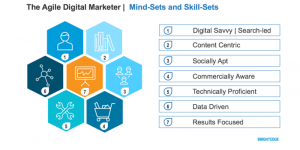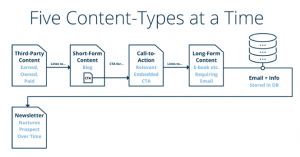By Liz Stinson
The office has become a place of contentious experimentation. It’s never been harder to know what the office means to workers today, and what it might mean in the future. Companies’ return-to-office mandates have created rifts between employers and employees, who are often at odds when it comes to where the best work gets done—in the office or at home.
But could a better office convince workers that coming in for their 9-to-5 is worth the commute? That is the question we set out to answer in our in-depth guide to the current state of office design and the RTO debate. For this report, Fast Company spoke with dozens of sources across the design world, workers in various sectors, real estate experts, and company executives to uncover what workers want from their offices today, and how leaders can help create an environment that exceeds those expectations.
From those conversations, one thing is clear: Building a better office isn’t just about fulfilling a wish list of amenities. Creating a workplace employees want to come back to requires an understanding of the current office’s shortcomings—and the willingness to design our way out of them. This report aims to help company leaders prepare themselves for the shape-shifting office of 2024 and beyond.
What you’ll learn from this report
- Which industries are coming back to the office and why
- Key office design trends that workers want
- Insights from CEOs and executives on how they’ve handled RTO
- Data-driven insights on the most and least-used office features
- How to maximize the benefits of an office lease in a tough market
Key sources
- Gensler
- NBBJ
- Rapt Studio
- So-Il
- SpacesOf
- Studio O+A
Introduction
Companies are facing an existential question: How, after more than three years of remote work, can they get employees back to the office? Not long ago, remote work was the exception, not the rule. According to a Gallup survey, 75% of workers were fully on-site in 2019, with only 4% of workers regularly working from home. During the height of the pandemic, those numbers flip-flopped, and office attendance plummeted by as much as 90% in major cities. Now, even with return-to-work mandates in full swing around the country and across almost all sectors, those levels have only rebounded to about half of pre-pandemic occupancy.
In short: Offices are still sitting empty most of the time.
The reasons are obvious enough—commuting eats up precious personal time, offices are full of distractions, and you can usually control the thermostat at home. But certain aspects of modern office design felt broken even before the pandemic. Open floor plans, conference rooms, and privacy booths were all initially meant to foster collaboration or allow for focus, but anyone who’s worked in such an office knows that rows of open seating can get noisy, and those privacy booths are about as comfortable as an airplane seat.
For the companies trying to figure out how to bring workers back to the office, this means they are now in the persuasion business, forced to reevaluate the appeal of the office itself. If the pandemic proved what employees long suspected—that the office wasn’t necessarily necessary to their jobs—can the right office design convince them otherwise?
This report aims to explore that fundamental question through the lens of workers, employers, and the designers who shape the office environment.
—Words by Margaret Rhodes
The office you want
To start, we posed a big question to some of the leading design firms in the U.S.: What does the office of 2024 look like? Fast Company turned to five architecture firms: Gensler, NBBJ, SpacesOf, SO – IL, and Studio O+A, each of which is grappling with with that challenge, both for clients and for their own firms. We learned that it’s not just the office floor plan that needs revision; it’s how those floor plans fit into a future where the typical Monday-to-Friday work week is no longer a given.
According to a McKinsey report from July 2023, the majority of office workers are combining one or two remote days with in-person days, with some subtle variation across levels of seniority and commuting distance. With that in mind, we gave each studio a specific return-to-work scenario, from the full-time return-to-work mandate to the hybrid office to one that’s designed for a Gen Z staff, and asked them to show us an office that you might actually want to go to. Here’s what they came up with.
The Full-Time Office
Design firm: SpacesOf
The challenge: The company has mandated a Monday-to-Friday return to work policy, and it is causing friction among employees.
The solution: Combine adaptive reuse with the old company housing model.
Aaron Taylor Harvey and Leila Khosrovi, cofounders of SpacesOf, don’t view the office as the problem—it’s the commute that’s keeping people at home. “People are really thinking about the time they’re committing in the car, and they don’t want to give it back,” Harvey says. Their conclusion? “The only way that you can make an office that people want to go to every day is if you make it directly adjacent to wherever they live.”
SpacesOf proposes pulling this off by converting mid-rise towers in urban downtowns into bustling mixed-use buildings that stack apartments on top of offices and leisure space—a contemporary version of the company housing model that was popular around the turn of the century.
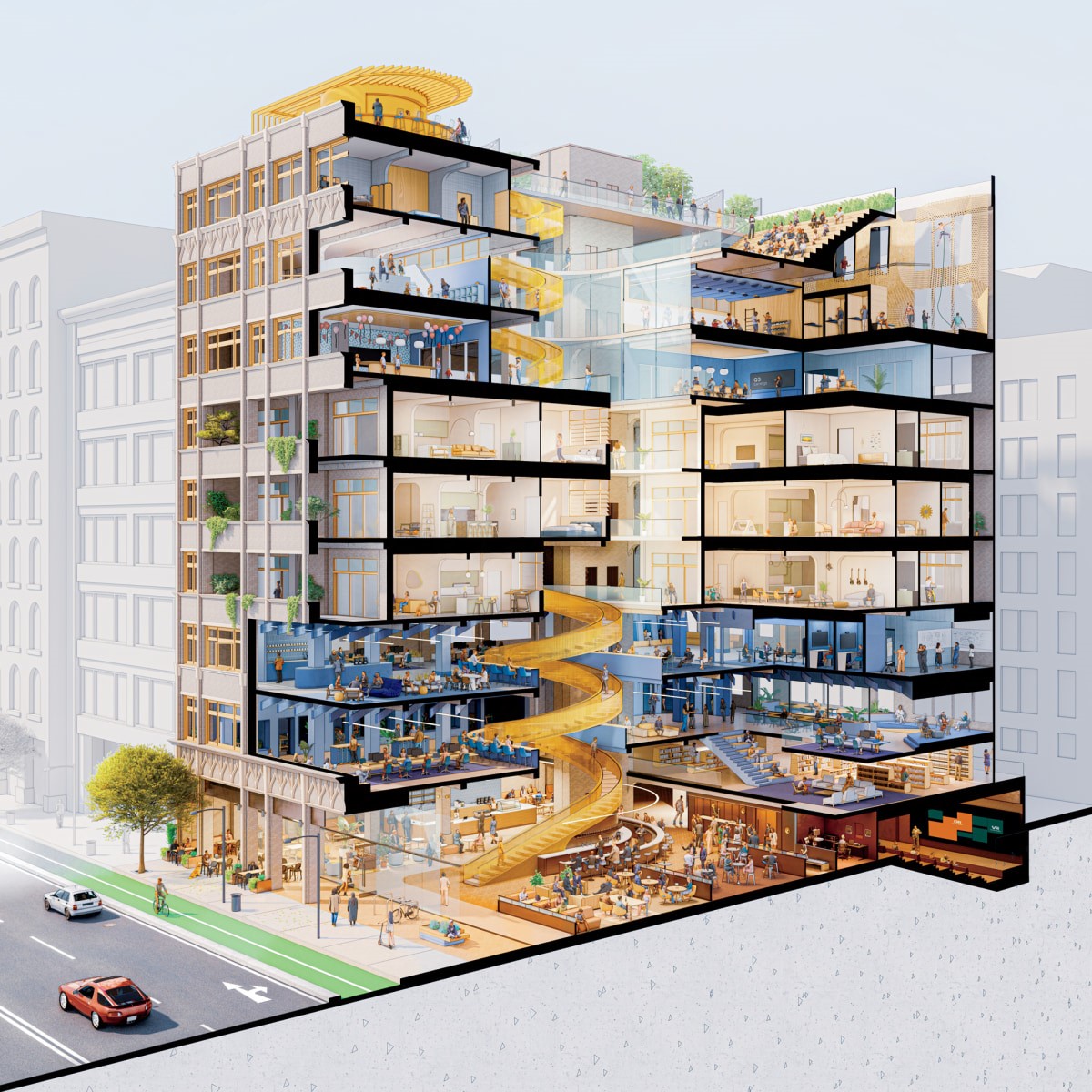
Specifically, Harvey and Khosrovi see a big opportunity in adapting buildings from the 1940s, which are abundant in American downtowns and originally designed with natural daylight in mind. Upper floors could be built out into compact apartments and offered to employees at an affordable rent; middle floors would be allocated toward desks, meeting rooms, a library, and an auditorium space for product launches and big team meetings. “These are the kinds of things that people are coming into work for,” Harvey says. “Large gathering spaces are actually what a lot of corporations need right now.”
Like those older (and now-defunct) company towns, these newer buildings would provide its employees with a suite of basic lifestyle needs, such as daycare facilities and fitness classes. They differ when it comes to their broader surroundings: Workers at this building wouldn’t be secluded in a small rural town; they’d be living in the middle of a downtown center, with restaurants, entertainment, and nightlife nearby. The building itself, thanks to a ground floor coffee shop, open-air arcade, and sidewalk seating, would also blend into the neighborhood. For those who choose to live on site, the crucial thing is that there’s zero time spent commuting. “If the company wants everyone to be in an office every day,” Harvey says, “then they have to provide the full set of conveniences, including housing and childcare. It’s the whole village.”
The True Hybrid Office
Design firm: NBBJ
The challenge: Employees are required to come into the office three days a week, and get to choose their own days. The space needs to flex between maximum capacity and emptier office days.
The solution: Throw out the old model of assigned desks and designated conference rooms; design a more fluid floor plan.
The state of return-to-office remains in flux, but so far, the data points to hybrid work as the new normal. A recent McKinsey report found that 56% of those surveyed have a regular hybrid work arrangement, and go into the office somewhere between one to four days a week. That number is even higher for millennial respondents, suggesting a lasting shift among those who will be in the workforce longer. Architecture firm NBBJ saw this shift coming early during the pandemic, and in 2020, while most office buildings were emptying out, it started tinkering with a new hybrid office prototype in the middle of Manhattan. Their team found that hybrid work is all about flexibility—and not just in terms of scheduling.
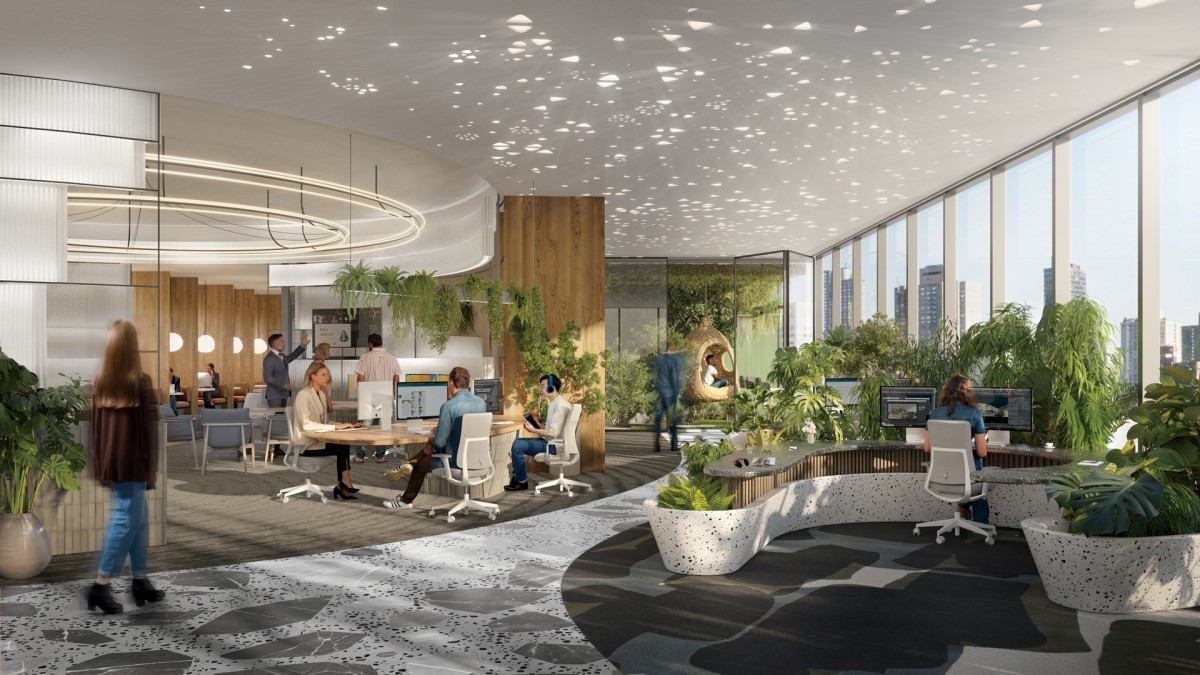
Part of NBBJ’s flexible office theory comes from a 2018 report in Translational Psychiatry that compares individuals to orchids, tulips, and dandelions. Each group responds differently to its environmental surroundings, requiring more or less precise conditions to thrive. In order to accommodate all three types (and all the hybrid types in between), NBBJ envisions an office where workers can move around freely, choosing tables or nooks that best suit them or their tasks. Instead of what partner Matthew Somerton calls “a sea of desks,” NBBJ’s hybrid office features shared tables in the middle of the floor, with booths, pods, and ample greenery lining the perimeter. (The emphasis on biophilia comes after a few studies, including one recently published in the Journal of Environmental Psychology, linked exposure to nature to higher cognitive performance and reduced stress.)
“We thought it was odd that we do all our collaboration in closed hermetic spaces, and our focus work out in the open,” says Somerton of typical open floor plan offices. NBBJ’s plan inverts that older model. Workers who need a bit of quiet can choose to work from booths or corner desks with full tech setups—what Somerton calls “three-sided offices and pocket parks”—and centrally located meeting areas are available for those who feed off others’ energy. The “mixer” tables also include screens, so that employees working remotely can feel more integrated into the office. And if it gets too noisy, employees can always book breakout rooms.
The Fully Remote Office
Design firm: SO – IL
The challenge: The company is embracing remote work, and no longer keeps a central office.
The solution: Give employees access to a network of physical spaces, spread across different time zones.
While most companies are adopting so-called “remote-capable” policies—implying that a physical office is still available—others are doubling down on remote work, choosing not to renew leases on office headquarters. For employees of those companies, working remotely doesn’t necessarily mean working from home. “Part of the reason that people are not going back to the office anymore is because of this desire to be outdoors and traveling,” says Florian Idenburg, a cofounder at SO – IL. Idenburg arrived at that observation after spending six years on The Office of Good Intentions: Human(s) Work, a Taschen book on the role of design in the workplace, but says he also noticed that desire among his own cohort. “I have a group of friends who have been completely nomadic, basically working in Airstreams and driving around the country,” he says.
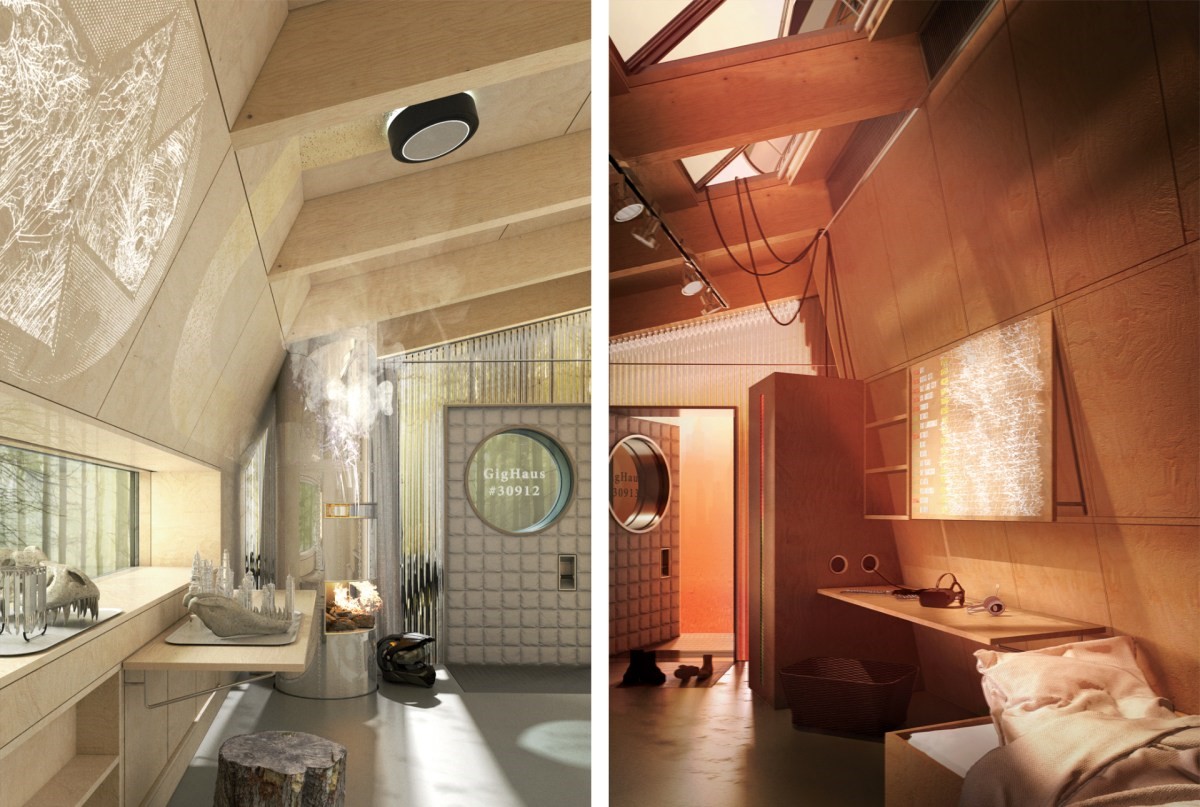
With that in mind, SO – IL dreamt up a network of prefabricated cabins that are managed by one company but scattered around the country—near, for example, state and national parks. Employees could book overnight stays at what Idenburg calls “gig houses,” and immediately tap into the company’s digital infrastructure upon checking in. Instead of computer monitors, each cabin comes with large wood veneer panels with LED digital displays showing work tasks and coding projects. Rather than sitting down and plugging into a desk, workers can use a provided headset and VR helmet to access team-wide projects and use AI-powered voice commands to dictate work. Wi-Fi and work tools would be available, from a cabin in the woods. A lot of the pain points that come with working on the road would cease to exist.
Idenburg acknowledges that a network of off-the-grid, solar-and-wind powered cabins is a futuristic proposal for any office configuration. But for companies that only exist across digital systems, these gig houses—or some subscription-based version of them—could also become a way to attract talent, encourage work-life balance, and offer workers the kind of freedom that remote work promises. “What’s the role of a designer in shaping the workspace?” Idenburg asks. “Are we making the workplace more humane, or is it just a way to keep people more trapped within a labor system?” The gig houses, by contrast, “suggest complete autonomy.”
The Suburban Office
Design firm: Studio O+A
The challenge: The CEO has inherited a suburban office park campus that they are remaking for a new business, and most employees have a driving commute.
The solution: Design an office park that functions like a town square.
A truism of the return-to-office movement is that people will come to work to see other people. Historically, offices haven’t lent themselves to spontaneous connections—at least, not to the degree that bosses say they do. “In the past, you would commute to some sort of office park, spend the whole day inside, grind out the day, and then go home,” says Primo Orpilla, O+A’s cofounder. “So, what is the new ritual of suburban work?”
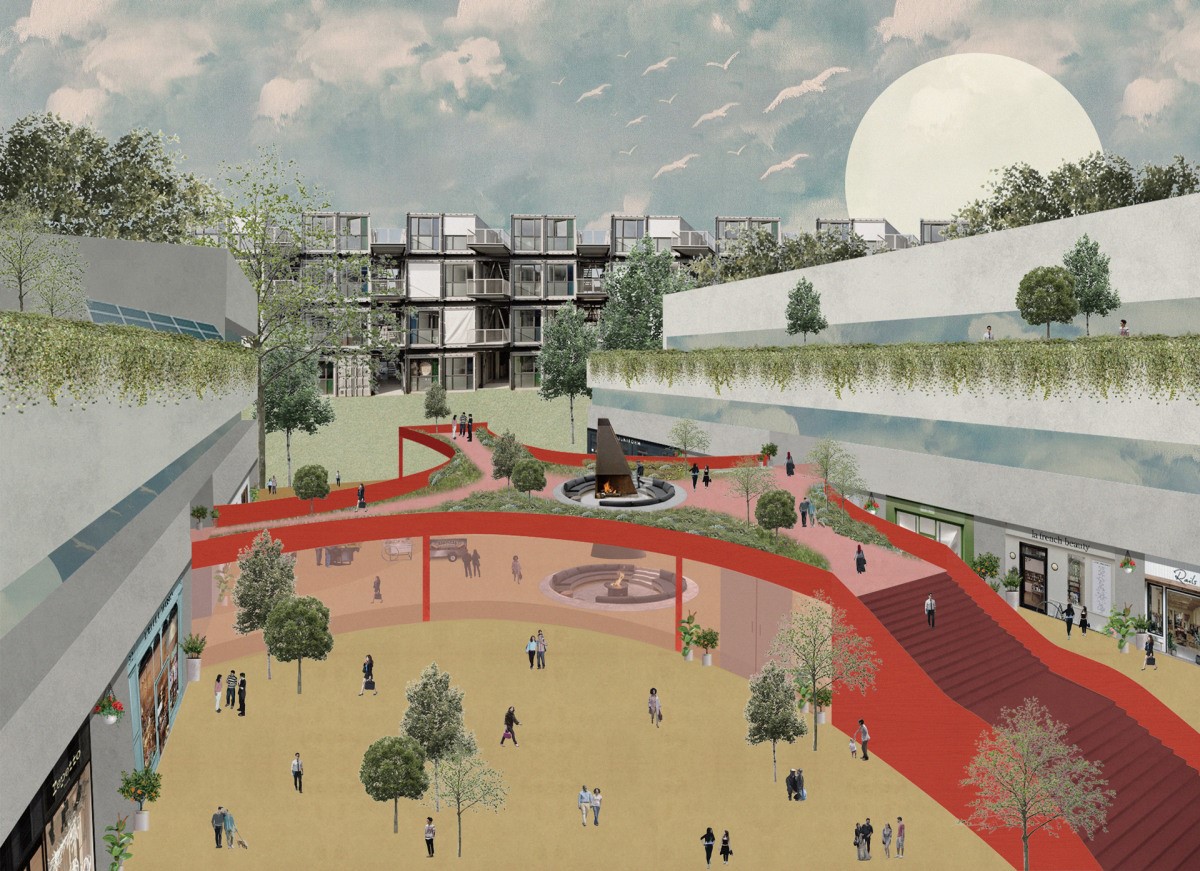
When Studio O+A started thinking about how to redesign the suburban office park for the new reality of hybrid work—in which people get to choose whether they come in or not—they saw an opportunity sitting right in front of them. Suburban campuses often sprawl, with buildings separated by empty paved lots. Studio O+A’s design turns those oft-underutilized areas into a bi-level town square, so employees returning to work can untether from their desks and socialize with their colleagues. The campus is anchored by the “connector,” a two-story structure with enclosed seating on the ground floor and open-air walkways on the upper platform. Benches and charging outlets give workers an alternate place to sit, and fire pits on both levels provide warmth during colder months, as well as an organic gathering point for meetings, planned or not. Design details like wind guardrails and central heating and cooling would make these alternative spaces available year-round.
Orpilla and his team also took into consideration the suburban commute, and the fact that every errand likely requires another drive. To make life more convenient for workers, businesses on the ground level would include services like daycare, dry cleaning and laundry, hair salons, banking, and preventative healthcare. “People need amenities besides foosball tables and a bar at work,” Orpilla says. “They need these basic things, and they don’t need them 30 minutes away.”
While it’s reminiscent of big tech campuses that offer drop-off laundry services for its young employees, these businesses would also be open to the public. The town square wouldn’t only belong to company workers; it would be shared with the community. The idea, Orpilla says, is to do away with the severe separation of your desk life and your personal life. “Maybe people initially come in because of the merchants,” he says, “but then they also have community, friends, and this agora for the sharing of ideas.”
The Gen Z Office
Design firm: Gensler
The challenge: Of the employees, 60% are under the age of 30—some never worked in an office before the pandemic.
The solution: Focus on individual agency and sustainability.
To design an office for Gen Z workers, Gensler turned to its own staff. In a charrette with some of the firm’s youngest employees, principals Jordan Goldstein and John McKinney learned that their colleagues want flexibility and choice in the workplace. “They don’t want to work in a linear pattern—they want to choose how they construct their day,” McKinney says. “They talked about how diversity and multiculturalism among the group was a baseline and a given, and that because of that, that there should be a lot of choice.”
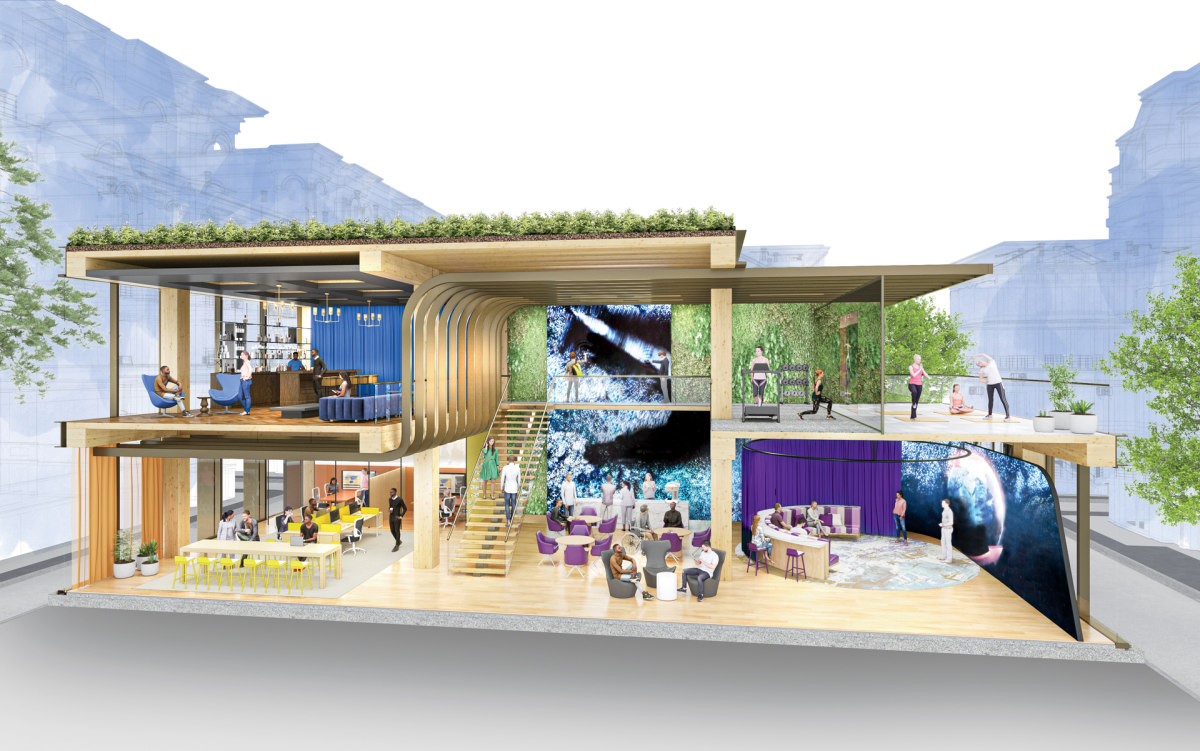
Gensler’s solution is a series of physical environments that employees can transition in and out of throughout the day. Employees might start the day in the ground floor atrium, at one of the communal tables, or they might go first to the upstairs lounge, which was designed to resemble a hotel lobby and flexes between a café and a bar, depending on the time of day. Later, they might meet around some of the communal desks or attend a larger presentation in the rotunda-like conference room. Crucially, these areas are open and not hierarchical, so that younger employees can make connections and seek mentorship.“The whole office becomes a series of opportunities and spatial environments that weave together, allowing for choice throughout a day,” Goldstein says. A two-story screen cuts through the atrium and landing, providing a fluid display for everything from all-hands meetings to product demos, and creating a sense of continuity throughout the office.
In addition to choice and transparency, Gensler’s Gen Zers also said they want to see sustainable design in the workplace. “They want to be able to visibly connect with it,” Goldstein says, pointing toward construction details like unfinished mass timber and biophilic elements like a living wall behind the two-story digital display.
—Reporting by Margaret Rhodes
Who’s actually returning to the office?
It depends on who you ask and where they live. Data from remote work software firm Scoop and Boston Consulting found the number of fully in-office workers across industries dropped this year from 49% to 38%. These numbers signal that the full-time office of yesteryear is a dying breed, even after repeated calls by big firms to come back or else.
The number of fully in-office workers dropped this year from 49% to 38%. The full-time office is a dying breed.
Scoop gets its data from its Flex Index, which tracks the in-office policies of more than 7,500 companies. In its most recent quarterly report, the data showed that remote dominates many industries: professional and financial services (87% flexible), insurance (91%), media (92%), and even the majority of real estate, facilities, and construction jobs.
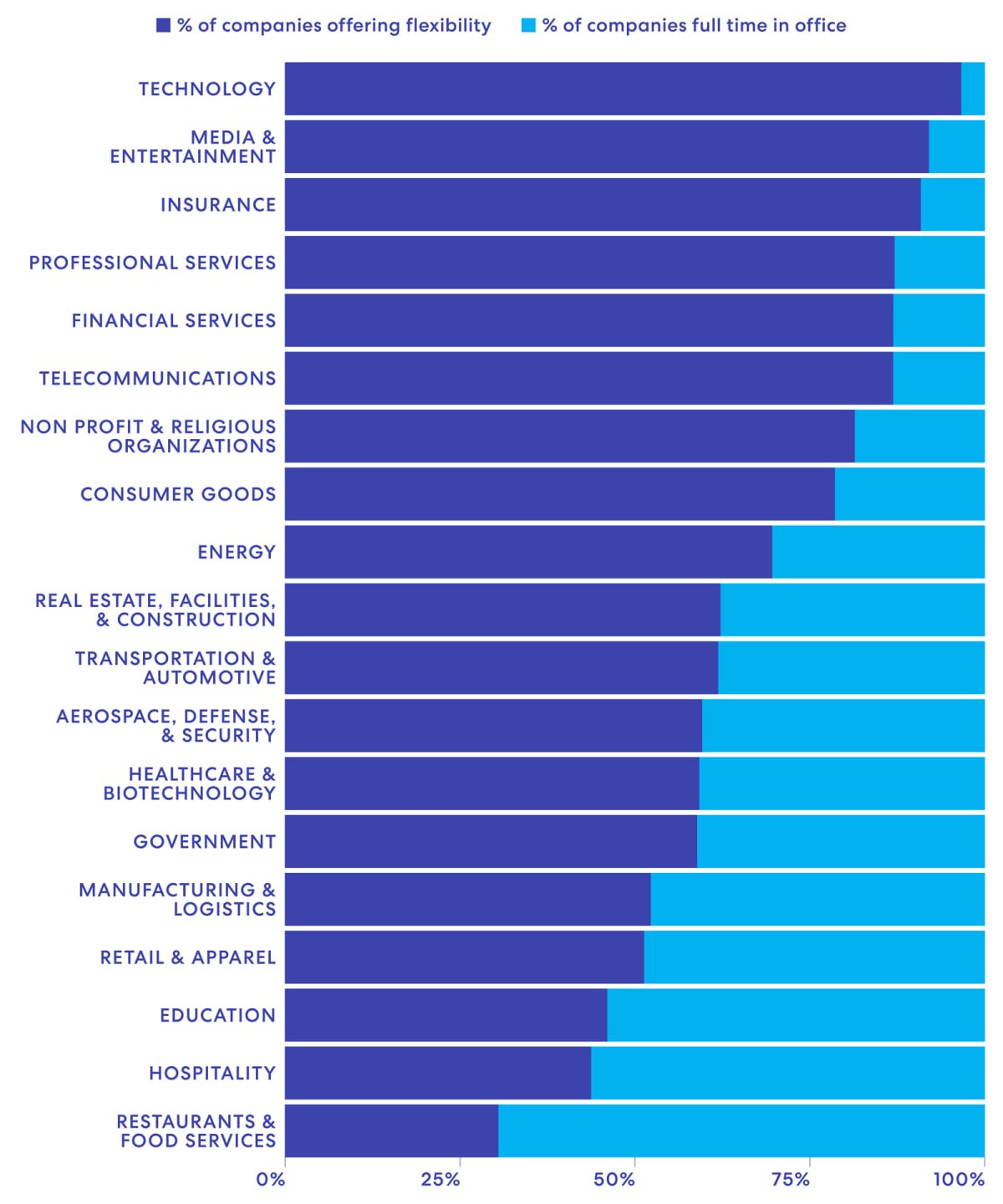
Unsurprisingly, the technology world, from the tools enabling the home office to the gigantic firms setting the corporate agenda around today’s workplace, has long defined remote work and the return to the office. To get a view of the future, look at today’s startups, which suggest remote will only become more prevalent.
Scoop found that 97% of technology companies offer fully remote or hybrid options. That’s why the firm’s quarterly flex report found hubs like San Jose, San Francisco, Austin, and Seattle rank as the nation’s most flexible metros, with 90% or more workers spending at least some time out of the office (in cities and states in the south, that plummets to 60%).
But distill that sample down to new startups, and remote becomes unavoidable. Businesses founded in 2021 or later were 93% remote—the rate declines the older a company gets, hitting 63% for those founded before 1980—while 74% of companies under 500 employees were fully flexible. For firms with head counts between 500 and 5,000, fully remote drops to 35%. Two-thirds of new firms under 100 employees were fully remote, says Rob Sadow, Scoop cofounder and CEO, and traded expensive real estate for broad access to talent.

“What’s going to happen over time is companies will age out,” Sadow says. “Newer companies aren’t getting started full time in the office, so a whole generation will never experience that. Twentysomethings that will be future executives will know no other experience but managing and leading in a flexible environment.”
—Reporting by Patrick Sisson
The office data designed
As hybrid work schedules remain common and office return policies struggle to catch on, many companies are seeing their offices only sparsely populated with workers on a daily basis. Many are wondering what they should do with these now oversized offices. A more precise and actionable question is: What are the spaces within these large offices that workers today actually use?
Increasingly, there is data that can help provide an answer. Indoor sensor companies like XY Sense and Butlr provide office buildings with technologies that can reveal where people spend time when they go to the office. By tracking movements and dwell times, these companies can show companies how their workers use their office space, which types of spaces are most popular, and how usage changes based on the time of day and the day of the week. They can also reveal which parts of an office are deserts, left mostly unused throughout the workweek.
With this kind of information in hand, companies can redesign their offices, replan their meeting room sizes, or even eliminate entire chunks of their overall square footage. Seeing how the space is used is the first step. Here’s what the data is showing now.
Double down on small meeting rooms

Butlr’s sensors track both the usage of a space and its fullness, helping companies to understand which types of spaces are popular, and which are perhaps bigger than they need to be. “We know just by looking at the data that people prefer to use dual meeting rooms, which is the smallest meeting room. It’s always occupied,” says Jiani Zeng, cofounder of Butlr. “When you look at the bigger meeting rooms, they’re less booked, and when people book them, they’re always underutilized. It’s designed for 10 people but there’s only one or two people using them.”
Get rid of shared desk space

This data also shows what types of workstations people want to use. In one customer’s office, Butlr’s data showed that shared desks were almost always empty, even on the busiest days. “Open desks are designed for collaboration but people are actually not using them. They always prefer to go to meeting rooms instead of spending time in open areas or hot desks,” Zeng says.
Rethink high-traffic zones

There may only be half as many people in an office today compared with 2019, but some places within that office still see a lot of coming and going. Hallways and the entrances to bathrooms are particularly high traffic zones, and according to Butlr’s data, workstations that are near those zones are almost always avoided. Knowing that people don’t want to work next to a constant stream of passersby, companies should rethink how they utilize spaces next to these naturally active areas.
Ditch the open ‘collaboration spaces‘

XY Sense has a data set of 100 billion data points a year, collected from buildings around the world. In aggregate, this data has given the company an eye on some of the biggest trends in the changing workplace. “When you talk about it, it’s actually pretty obvious. The enclosed small collaboration space is the most popular type of space across the world,” says XY Sense CEO Alex Birch. The company’s data shows these rooms being used more than three times as much as open collaboration spaces. “Our theory behind that is there are more people that are remote, so there’s less need for a larger room, and people are going to smaller rooms to have their remote calls instead of staying at their desks.”
Create the spaces people want to use

Technology giant Cisco has developed a platform for tracking and analyzing office usage, called Spaces. The data collected through this platform has helped companies around the world to better understand how their offices function. Cisco uses Spaces for its own offices, and has gathered insights into the ways its real estate portfolio functions, down to the fact that most of its employees tend to do most of their work either alone or in small groups of three or less. They’ve used that insight to shape their office layouts. “We now are building 70% minimum ‘we’ space, 30% ‘me’ space,” says Bob Cicero, Cisco’s Americas hybrid work and sustainable real estate leader.
Let what works inform future real estate decisions

Cisco has used the data from one of its offices to directly influence the design of another. When the company was planning a redesign of an office in Atlanta, it turned to the historical use data of its New York office and identified the types of spaces—and sometimes specific rooms—that were most used and most popular. One particular meeting room stood out for how often it was booked and fully occupied. “We used that data to prove that people loved it, so we built four of those types of rooms down in Atlanta,” Cicero says. This type of data-based design decision making is now being used to determine the look and feel of all new Cisco offices. “We’ll look at all these data sets consistently. It’s just something we’ve built into how we manage and look at space now when we’re going to do future projects,” Cicero says.
—Reporting by Nate Berg
Location, location, location
So, if you’re a young company looking to lease office space, where should you put down roots to attract the right talent? A few cities are faring better than the rest. The clobbering commercial real estate teams have experienced due to hybrid work schedules and remote work has been well documented: Every week seems to bring additional reports about financial pressures facing landlords and stagnant employee activity. But the office apocalypse isn’t as severe, or evenly distributed, as headlines might make it out to be. Analysts and experts at Avison Young, a commercial real estate brokerage and advisory who have faith in the long-term value of the office, mapped out leasing activity in a handful of major U.S. cities, finding new rules for active offices.
As Harry Klaff, Avison Young’s Principal and U.S. President, and Danny Mangru, the firm’s Capital Market principal, explain, no single narrative explains each city—all are multidimensional and contend with a shift toward high-quality office space, migration to the Sun Belt, and renewed focus on transportation. But within these four maps lie lessons for the future of the office market.
Manhattan: Train Traffic is Better Than Foot Traffic
Suburban commuters have bolstered office buildings across New York City, signaling that they want to get to the office—and get out—as fast as possible. Avison Young found that despite a struggling market, Manhattan boasts record-high total availability and transit-dense areas like Central Park and Hudson Yards have weathered the real estate recession relatively well.
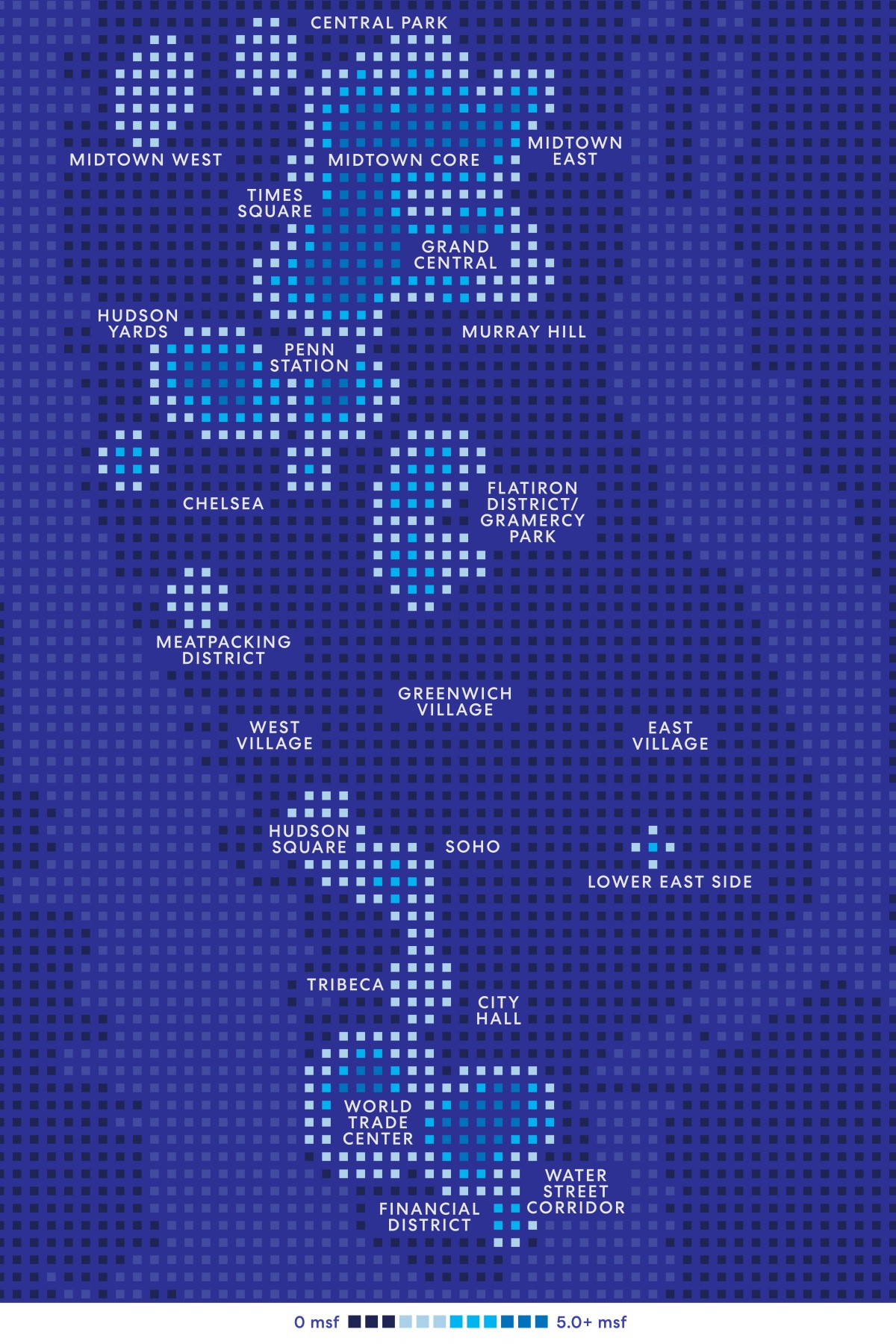
The difference between Wall Street, on the tip of the island, and Midtown, near suburban-serving rail, is “night and day,” says Klaff. Since March 2020, the vast majority of 100,000-square foot leases signed in the city have been near Penn Station, Grand Central, and Times Square. For workers coming downtown, the ability to walk out of Grand Central and basically walk into One Vanderbilt, a gleaming new tower near the station, is “a nice bonus,” says Mangru.
Chicago: Happy Hour Isn’t Dead
The city’s famous skyline has long centered around the Loop, a downtown business district built for commerce a century ago. Circled by rivers and elevated rail, it’s more vacant than ever after recent shifts in the workplace. But head west, over the movable bridges spanning the river, and you’ll see where the action is, real estate-wise. The West Loop and Fulton Market, the latter a warehouse-district turned into cool condos and a ritzy restaurant row, have seen office activity flourish due to the live-work-play aspect of the neighborhood. West Loop’s location near commuter trains and light rail have helped towers here maintain high rental rates, and even poach tenants. Fulton Market has grown by more than 4 million square feet in the past five years, with cranes still swinging above active construction sites.
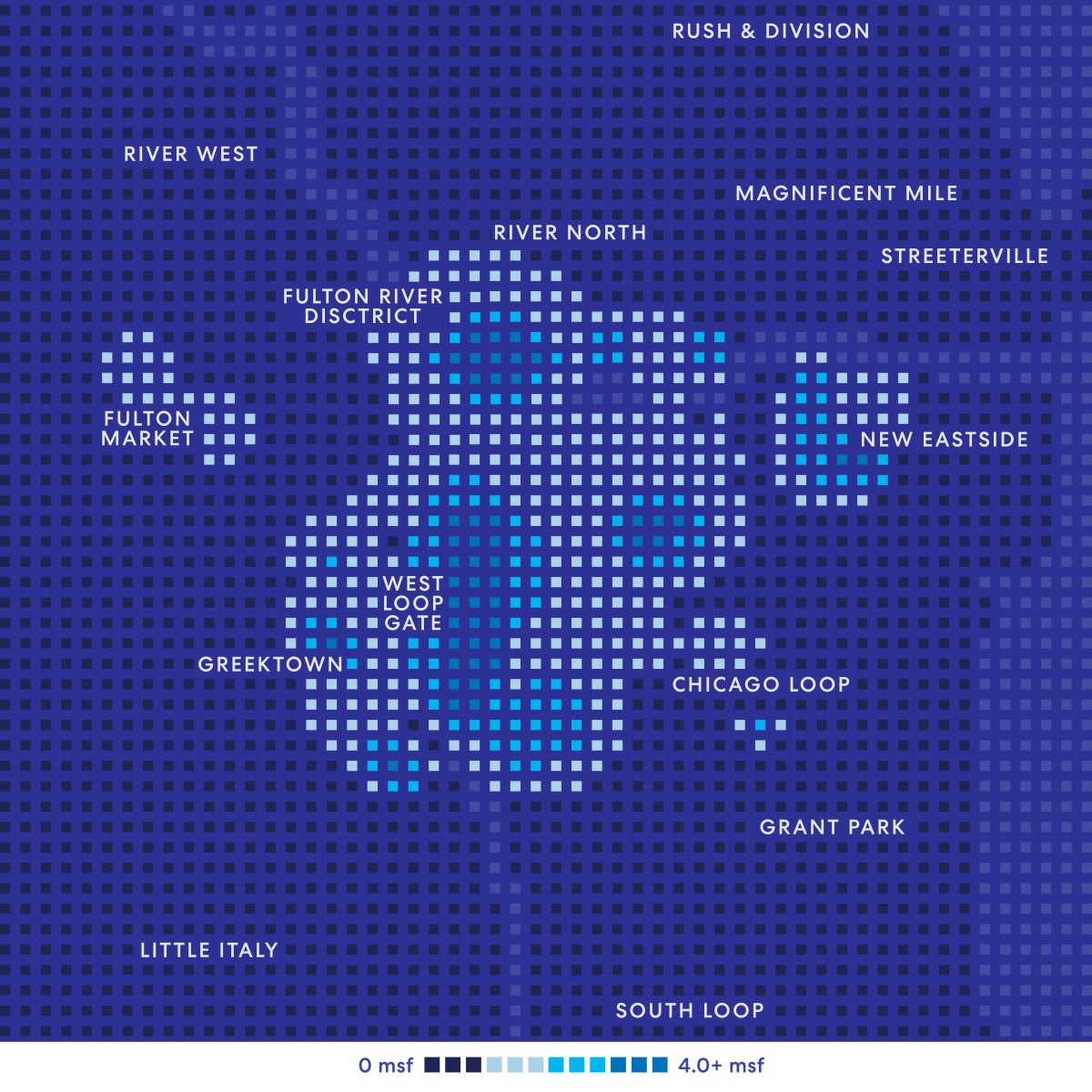
The residential magnet effect is perhaps most pronounced on the LaSalle corridor, an strip of planned office-to-residential conversions that happen to sit in a housing dead zone amid empty office space. The city hopes sparking transformation there will revitalize the city’s storied office stock.
San Francisco: Luxury Leads
As a tech-centered, incredibly expensive market, San Francisco may have fallen the furthest, with offices emptying out and creating doom loop debates about the city’s future. But in the Financial District, the center of high-end, trophy office space, leasing remains strong. This is partially a response to the dearth of new offices built here in recent years. Tech demand and rents soared so high, landlords didn’t feel the need to invest when profits poured in. So top-flight buildings have seen activity, including larger leases by Quantcast, Hive, and Patreon in SOMA, and big deals from AI firms, which are beginning to sign for serious square footage adjacent to downtown, including big leases by Anthropic and OpenAI in Mission Bay. Still, the overwhelming majority of large leases since 2020 have been signed in the Financial District. “That’s probably the one bright spot in San Francisco,” says Mangru. And as the boom and bust of the city’s history suggests, that’s more than enough to drive an office frenzy.
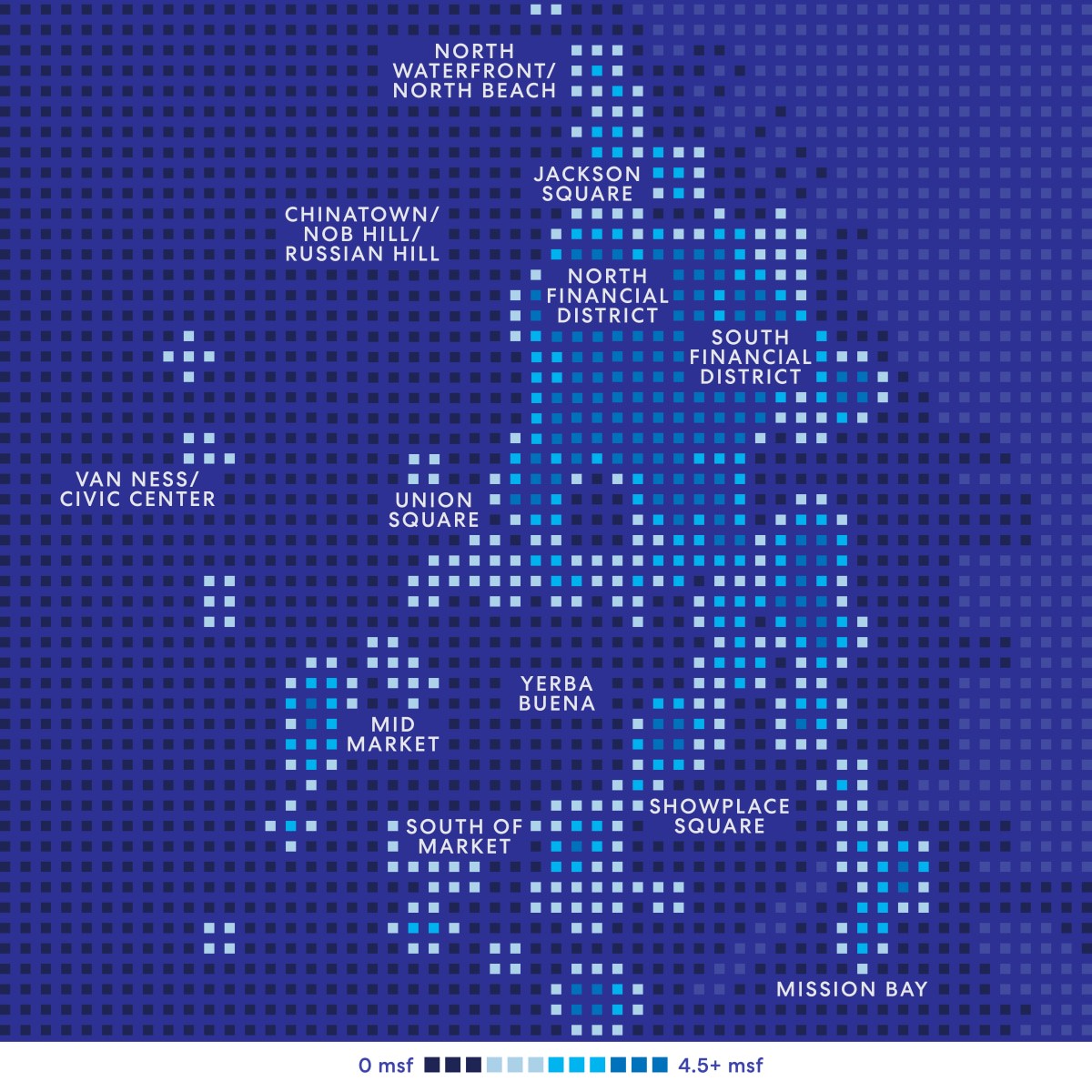
Houston: Invest in Innovation
This Texan metropolis has long been a one-horse town. Energy, namely oil and gas, have long dominated the office market. The energy bust and pandemic have underscored that historical lack of diversity; as of fall 2023, Houston’s total office availability stands at 30.2%, making its offices the fifth most empty of a major U.S. metro. There are bright spots, however.
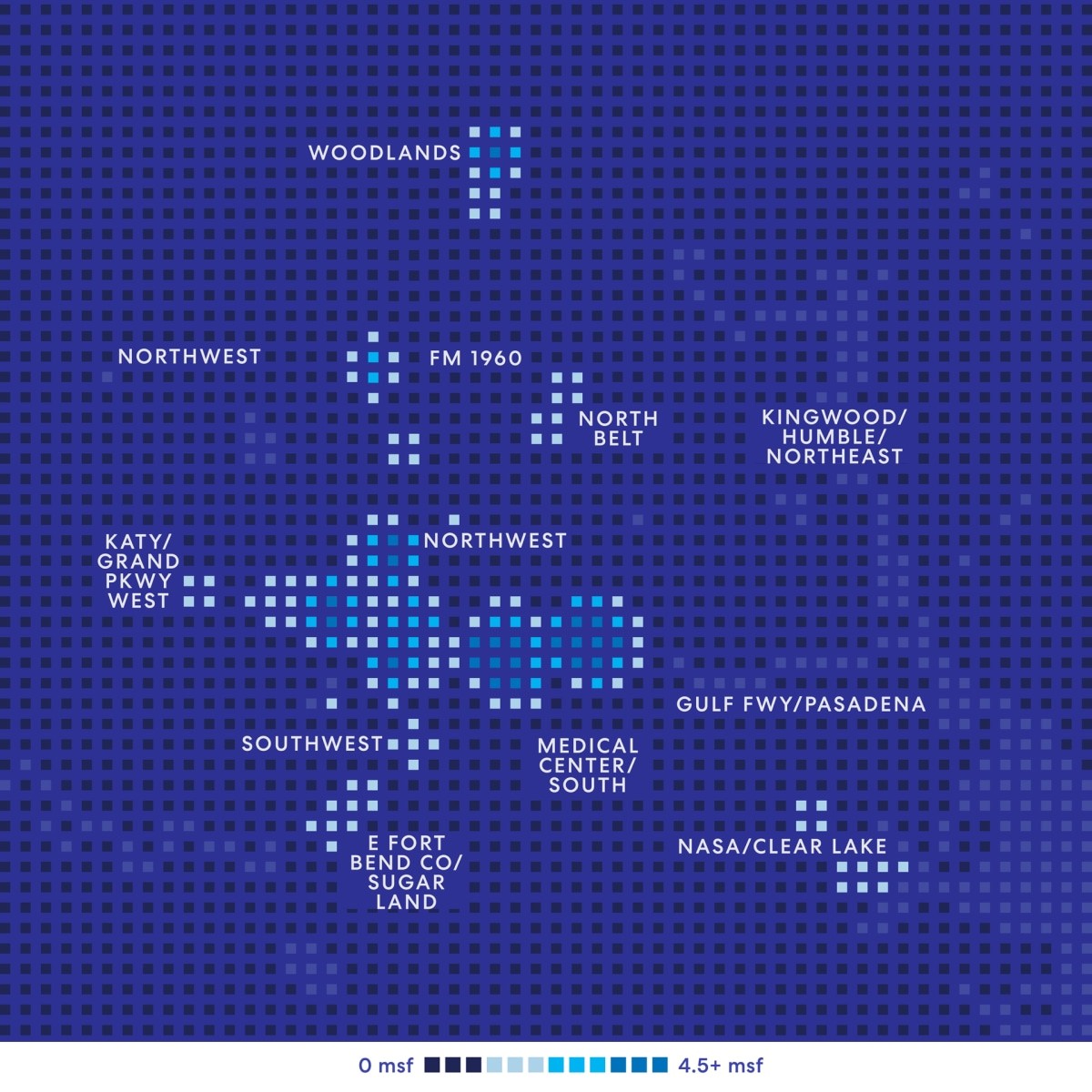
In recent years, efforts to diversify the downtown, including introducing rail and new industries, have catalyzed activity in small little pockets across the city. One of the brighter lights has been the Medical Center, site of Helix Park, a new 37-acre research hub developed to take advantage of the city’s large medical district and existing research talent (additional medical schools coming downtown will only add to the talent and spinoffs seeking offices). In general, medical developments and medical office have been strong performers, Avison Young has found, and the new high-tech lab buildings opening in Houston. “It’s outperforming the rest of the market,” says Mangru of the Medical Center. “It’s got almost inelastic demand,” he adds, suggesting its popularity will surge regardless of rising prices.
—Reporting by Patrick Sission
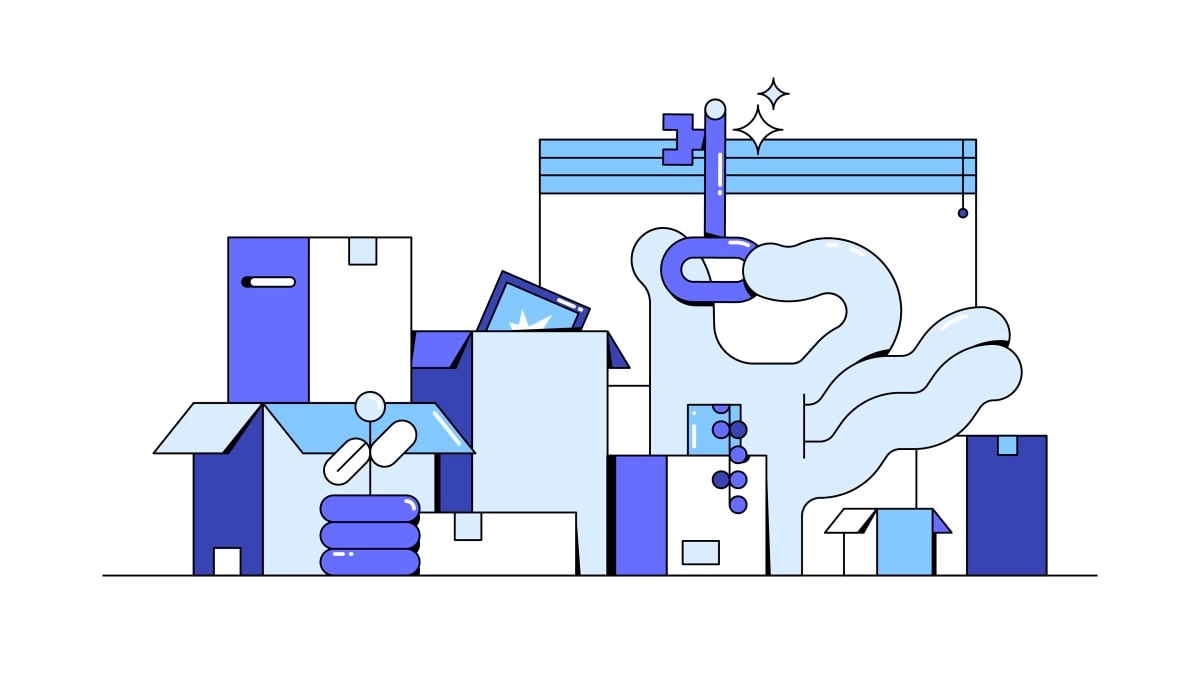
It’s a renter’s market: How to get the most out of your landlord
Even with all the data in the world, there’s no crystal ball that can tell us what the future holds for offices. But experts agree that, for those who are currently in the market for a physical space to run a business, now is an advantageous moment to be an office tenant. Landlords are facing huge vacancies and gargantuan loans are coming due, and many are willing to invest heavily to keep current tenants and lure new ones in. That’s taken the form of everything from discounted rent to funding the interior construction of office spaces to new office building amenities and even free furniture.
To learn more about the state of affairs in the office market, Fast Company spoke with real estate brokers, facilities managers, designers, and experts. Here’s how the office market is changing for landlords, building owners, and banks—and the better-than-ever deals office tenants can expect to get right now.
Concessions grab bag
“There’s probably never been a better time to be a tenant. The market is in a new stage of being reset. Landlords are reducing their rents significantly, they’re increasing their work allowances significantly, and also increasing the free rent period. . . . I’d say the numbers for tenants have improved 30% since 2019. You can expect on a raw space [in a class A building in New York] that you will get a work allowance of about $130 to $150 a square foot, which is what is required to build a space. On a 10-year lease—and a 10-year lease is required for a build out—you would get 12 to 15 months of free rent.
There’s probably never been a better time to be a tenant. The market is in a new stage of being reset.
In the past landlords build out offices to 80% of cost. They’re now building it out up to 100% of cost. Or they will throw in some additional things. They’ll put in the marble reception area, when before it would have been a carpeted reception area. And a lot of the major landlords are building amenity centers, which is a huge cost for them.” —Ruth Colp-Haber, partner, Wharton Property Advisors, Inc., New York, and Counselor of Real Estate
Tenants have the leverage
“Some tenants will say, ‘we’ll stay here.’ They will take maybe less space, but they’ll also ask the landlord to spend a lot of money to fix it up and make it pristine. There are several organizations that I know where the landlord just renovated their offices entirely just because they wanted them to stay. The company that was next door to my office, the landlord basically took that tenant and gave them a whole new office space, desks and everything.” —Robert Pliska, president, Sperry Commercial Global Affiliates, Birmingham, Michigan
“Now you can most likely get furniture and some moving costs covered, and on top of that some free rent. We’re seeing that in some cases double what it was previously.” —Mike Brehm, partner, Kenwood Commercial, Minneapolis, Minnesota
. . . But only so much leverage
“The cities that are more walkable, more livable, more integrated, particularly as you see them oftentimes in Europe—they have much lower vacancy rates. So, your ability to negotiate is limited to a degree. But even there, you’re starting to see requests for more amenities.” —Jeffrey Spaulding, CEO, Nordic Foresight, Copenhagen, Denmark
“Adding something like a cafe is never an easy thing, so you’d have to be a really big user and pulling a lot of weight to have something like that happen. But if you’re a typical 3,000 to 10,000 square foot tenant, your requests might be driven around ‘I need more third workplaces’ or ‘I need more conferencing opportunities.’” —Nils Snyder, partner, Kenwood Commercial, Minneapolis, Minnesota
“For the best-in-class buildings, you’re not going to have as much negotiating power as you will with your A-minus and B buildings. It all depends, submarket to submarket. If you’re looking in downtown Minneapolis at a B building, then you have all the negotiating power that we’ve historically ever seen.” —Mike Brehm
—Reporting by Nate Berg
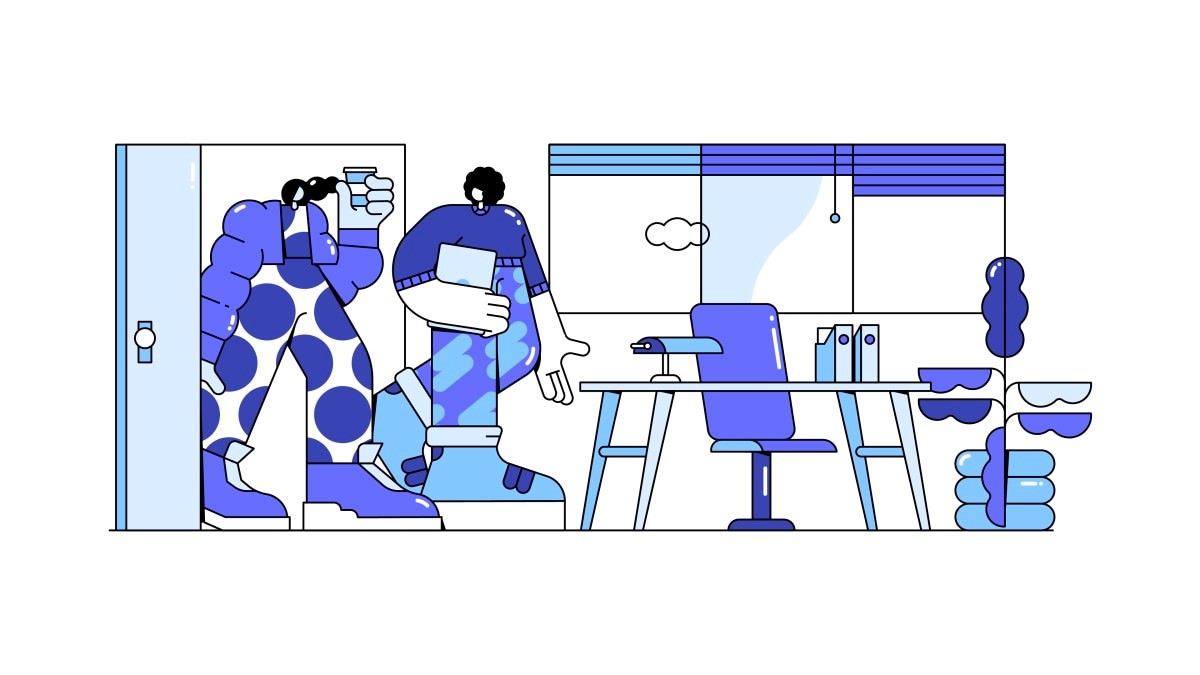
5 CEOs on how RTO is really going
The post-pandemic return to the office has been a process of trial and error, particularly for leaders, who are accustomed to having all the answers. We spoke to executives who shared what’s been working, and what hasn’t in bringing people back.
Embrace evolution
“We closed our office in March [2020] and went fully remote for about a year. We moved into this space in November of last year; we built it out and spent all this money. When we took the space, we were like: Let’s get a long-term lease because prices were low because of [the pandemic], and let’s take a lot of square footage because we’re signing a 10-year deal and then we’ll have space to grow.
“We’re now about 200 people—about 60% of our people are in Boston and 40% are remote. It’s really hard to get everyone back. As a leader, you have to figure out the few moments that you want to have everybody around, and then figure out how to foster collaboration and communication—what we call it collision.
“The business is thriving, but when you walk around our 35,000 square foot office with 20 people in it, it feels like we’re going out of business. We felt after [the pandemic] people probably wouldn’t want to be close to each other, but we actually found the opposite. They don’t go to the wide open spaces where you have plenty of room. They go to the areas where they’re on top of each other. We’re going to downsize, and we will definitely optimize for putting people on top of each other again. It’s not like [they want] offices where they can close the door—it’s like, put me in the pit with everyone else.” —Mike Salguero, founder and CEO of ButcherBox
Make the commute worth it
“We see a lot of people coming in more than the requested three days a week. Part of our thinking was, if we’re going to call people back to the office, we wanted a space that was very comfortable, made them productive, but also made them feel like there was a reason that they weren’t working at their house. We knew that we needed to have a space that felt worthy of the commute and the lack of flexibility.
“We wanted to use design to bring in that more casual feel. We looked a lot to different hospitality features. There are barstools at a counter, there are two lunch areas, there’s soft seating and couch breakout areas, living room vibe areas, more professional conference rooms.
“There’s tons of bright color everywhere, there’s gradients, lots of plants. We really wanted the space to feel like you were walking into the Magic Spoon universe, and be super immersive. It really was a stake in the ground that it was different from working at home.
“Running a physical product company, you do just need to often look at the dimensions of a box in person and confirm it works. So, we’ve tried to create places where you can go and do that. I think if everyone was just sitting on a screen taking video calls and they were just in the office versus home, that trade-off probably feels less worth it to them. I think it does work. If people are having fun then they’re more likely to come in, and that was the goal.” —Greg Sewitz, co-CEO of Magic Spoon
Make the office an event
“We have not made hard requirements. It’s kind of surprising to me that there are a lot of companies that are just mandating return to office seemingly without great reasoning. Or at least if they have reasoning they aren’t disclosing it.
“I personally have been coming in a lot, almost every day lately. Mostly because my dog really likes coming into the office, is the real truth of the matter. He walks up to me every morning and stares at me like, ‘Are you going to take me in or what? I want to see my friends.’
“We’ve continued to watch how people use our offices. I think we have about 25% of the people in Tuesday, Wednesday, Thursday. We designed the office for hybrid, so there’s a lot of flex space to support these programmatic uses, like the product team is going to come in and do the quarterly product business review. That was a really good decision. That has worked out really well. Probably the best use we get out of the office is when people do these events. And if I would do it over again, I would definitely do that again.” —George Fraser, CEO of Fivetran
I personally have been coming in a lot, almost every day lately. Mostly because my dog really likes coming into the office.
Restructure expectations
“Our in-office presence strategy is focused on delivering our business goals and fostering our culture. To realize this, our corporate workplace model was built on the concept of “presence with purpose.” We expect employees to be in office at least 25% of the time and to ensure this time is meaningful, rather than fulfilling an arbitrary requirement, we’ve established what we call ‘core weeks.’
“During core weeks (roughly 22 per year) we coordinate major meetings and events—from ideation and planning sessions, farmer’s markets, and food trucks to external speakers and educational series. Employees typically come in for two to three days each core week, and are encouraged to prioritize engagement with colleagues, including both formal meetings and informal connections, such as grabbing coffee or lunch. We believe this structure offers the right balance of individual flexibility with face-to-face collaboration.” —Mark Smuckers, CEO of Smuckers
Embrace flexibility
“While our front-line staff remained in office and at our resorts throughout the pandemic, corporate associates required a different approach. As we completed a new global corporate headquarters in Orlando this fall, we took the opportunity to rethink our work model while navigating the return to office for our 1,500 Orlando-based corporate associates. Taking a ‘human-centric’ approach, we implemented what we call an ‘adaptable work model,’ which empowers different departments and teams within the company to decide whether an in-office, remote, or hybrid work model suits them best. This gives our teams the freedom and flexibility to choose how and when their associates will work from the new headquarters while still meeting business needs.
“We also incorporated amenities that promote overall health and well-being such as a state-of-the-art workout facility, live green walls, ergonomic, low VOC furniture, and innovative, open, and collaborative work and meeting spaces, promoting intentional collaboration and celebratory moments to maximize our time together. This approach has remained popular among our associates with internal surveys showing hybrid work and flexibility continue to be top of mind for our people.” —John Geller, president and CEO, Marriott Vacations Worldwide
—Reporting by Nate Berg, Elissaveta Brandon, and Liz Stinson

Generational Gripes
And how do workers themselves feel about being back in the office? There’s almost a soap opera-ish quality to the ongoing struggle between corporations and workers to define the new rules of the workplace. The relationship is, bluntly, in flux. But the will-we-or-won’t we binary about remote or return some have taken not only misses the great middle that tends to favor a hybrid approach, but also overlooks the gradients and gray areas of personal experience that often inform what, if anything, an in-person office experience means today. Fast Company asked workers across generations about what it would take to get them back into an office five days a week, and every one had a personal, nuanced take about how important cubicles and collaboration truly are today.
“Obviously during the pandemic, things had to start moving more remote. I ended up leaving New York and moving in with my parents in Maryland when freelancing roles started dropping off. It was necessary. But I really value being around other people, and I think I always look for opportunities to be in person. Not wanting to be in office will reduce the number of opportunities you have. I think I would be open to a five-day-a-week in person. But every single day doesn’t feel necessary. I’m working with a friend, a director, on her student film next weekend, and we’ve been doing prep work online, but we’ll be in person next weekend.” —Jazmine Lawrence, 26, creative producer living in New York City
“If five-day-a-week in the office was a mandate, I’d go back. I wouldn’t quit. I’m back in the office three days a week now, and will caveat that my apartment is a 10-minute walk from the office. I like being around people. Advertising is so collaborative. If we can get in a room with creatives, it’s 1,000 times easier than trying to deal with a pitch over Zoom. Small talk over Zoom is just not the same. That’s a huge reason why I’m pro being back in the office. I don’t think I would ever want to be fully remote. I also think people who started their career fully remote are much more apt to want to stay that way. But I also think it’s definitely stunted career growth. People are lazier and more complacent.” —Kate Wallace, 29, account manager with ad agency VMLY&R in New York City office
I don’t think I would ever want to be fully remote. I think it’s definitely stunted career growth.
“I have complete control over my own time and schedule, and I make good money, work less hours, and do work that I care about and that matters. I have a heavenly office space that I helped design and share with two friends in an old printing factory and an at-home office that I use frequently. I will never work ‘full-time’ in an office again. Hell, I’ll never work ‘full-time’ again. I need autonomy and agency. It would have to be the craziest, most badass job that would even spark my interest. If Chuck Norris and Simone de Beavouir (resurrected) called me up and said they wanted to make a philosophical, feminist kung fu movie at a coworking space in Lisbon and needed my advice for four days a week, I’d probably say yes, but I’d still put them on a six-month contract and explain my working style.” — Laura Hilliger, 41, founding member and director at We Are Open Cooperative, a coop creative consulting group
“We’ve got R&D, we’ve got manufacturing to build our machines, and we’ve got construction, which you can’t do remotely. In March 2020, we sheltered in place—let’s flatten the curve—and when it ended, we needed to make five years of HR policy decisions in a few weeks. So, we sent the engineers back, and people on the support team could stay at home; I hunkered down in the Midwest to be near work sites, so I could drive out in case we couldn’t fly. This is, for me, my biggest learning. What happened next was, there was mistrust that emerged. Now we’re all back in the office, and it’s changed the culture. I think that you need the oxytocin flying, you need to feel a bond. There’s a big divide in Silicon Valley today; if you’re building hardware, you’ve been back in the office since shelter in place ended.” —Kim Abrams, 44, cofounder and CEO of Petra, an underground robotic construction company
“I like that I can live anywhere. I live in Wellington, a small town in West Palm Beach, Florida where I moved during the pandemic. I don’t exactly love where I’m living, but my wife really likes Florida. It’s been all good to be remote and have a kid. I’m even taking classes at Harvard’s extension school, and wrote a paper that got published. I think the hybrid model is a joke; if it’s hybrid, it still determines where you live. There are certainly benefits to going back to the office. If I had a local office where it was reasonable to commute, I wouldn’t mind a hybrid situation. I might actually enjoy it because you get to know your coworkers better. But I have a daughter whose three who I can now spend way more time with. It seems wrong to say I want to go back to the office so that I can ignore my daughter.”— Ian Kelk, 45, product marketing manager at Clarifai, a remote-first computer vision platform company
“I was working at Bed Bath and Beyond when [the pandemic] hit. There was a panic because the entire office that month was shifted from cubicles and offices to a completely open plan, with the exception of the C-suite. It was bad from the get-go, and it was just to pack more bodies in a smaller space—pure economics. I would have kept the cubicles, and I would have kept directors in their offices that also functioned as meeting rooms. Maybe it’s kind of old school, patriarchal corporate thinking, which is what I was brought up in, but cubicles and corner offices did provide a certain amount of stability. Now I’m at a different home furnishings company, RGI, which was recently acquired by Mayzon. I go in three times a week. The office is very well thought out. There’s a beautiful kitchen area, a place to dine, and there seems to be a far healthier camaraderie. There’s been this level of trust, which makes a big difference, and was something I didn’t feel at Bed Bath and Beyond.” —Barbara Weston-Robinson, 70, former global trend and design director at Bed Bath & Beyond
“We were in Montclair, New Jersey, but we also had just rented an office in Hudson Yards. Our lease was signed for March 1, 2020, so we never actually got there. I was one of those people who insisted you had to be in the office—I only hired people from North Jersey. I like the whole bouncing neurons, people sharing ideas, having lunch together. Then, when [the pandemic] happened, we started Zoom right away like many people did, and what happened is, we became better managers. I really mean that. I’m not saying this is for everybody, but I did it better that way. We ended up having a couple meetings in Hudson Yards and then we let that lease fall, too, and then we ended up doing nothing, and to this day, we still have nothing. I don’t think we’ll go back to the office because we still spend time together. I don’t see the need to. I think for most people it’s a waste of energy to be in there.” —Michael Potters, 68, cofounder of Glenmont Group, an executive search firm
—Reporting by Patrick Sisson and Rebecca Barker
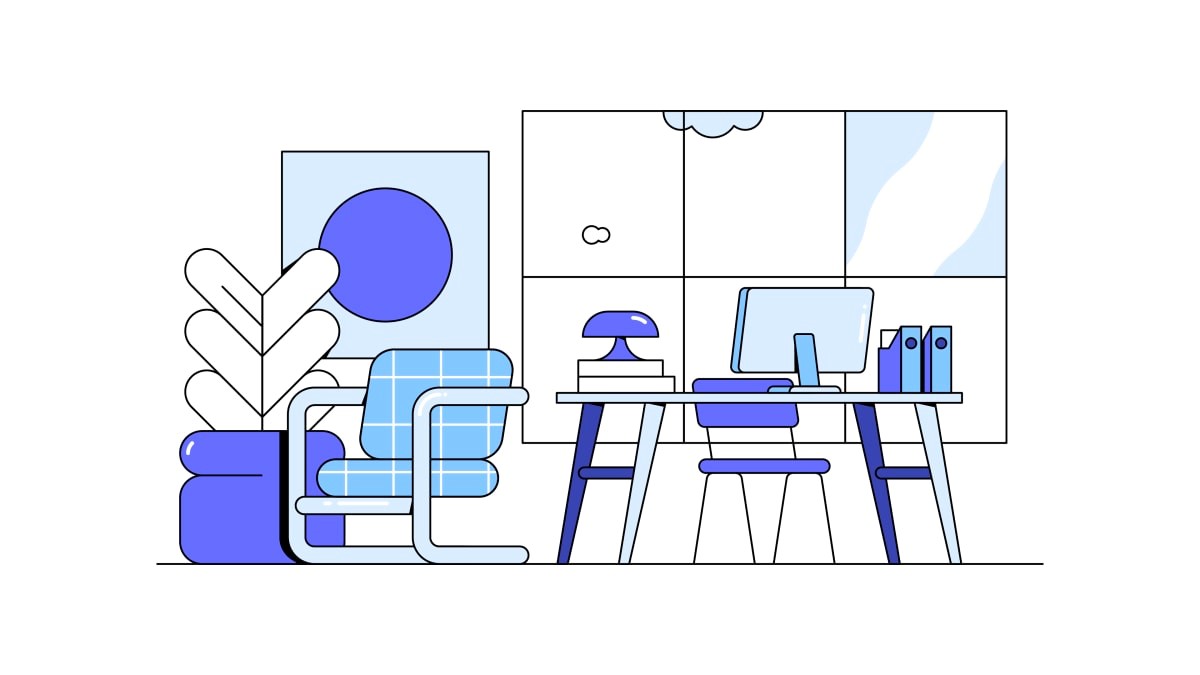
The new rules of office design
It’s nearly impossible to synthesize an entire report’s worth of knowledge into, but that’s exactly what we asked ten of the leading architecture and interiors firms to do. When faced with the question—what is your number one rule of design for this new era of the office?—they came back with a list of ideas that can help guide decision-makers when thinking about the office of 2024 and beyond.
Design with intent
“With every coffee shop, hotel lobby, and model apartment starting to buzz at the same design frequency, it is important to design an office that is true to the place, to the company’s purpose, to the very truth about why people work there. Are you a company that believes in the promise of community-building? Place your office in a storefront and welcome the public in. Are you a company that believes in choice and mobility? Then design your offices in a series of hub locations that allow for engagement and collaboration in a variety of settings. Is your truth built on the idea that any idea may be the next big one and that it may come from anyone? Build an office that is transparent, user-hackable, and dynamic—an office that shows that nothing is complete and that there is always more to do.” —David Galullo, Rapt Studio
Design places to go, not desks in a row
Restaurants are booked weeks in advance; live music is a gold mine, hotels are full, and tourism is up. The tyranny of delivered convenience is coming to an end. People need places to go. Work is one of those places. If we take seriously the social, educational, and creative role workplaces have in our lives, we can create purpose-driven space that celebrates the power of physical presence. Work becomes a destination not by pretending to be a house (“resimercial”) or a hotel lobby but by framing and assisting the most essential of human activities: people in a room making things. —Aaron Taylor Harvey, founder and creative director of SpacesOf
Design for connection
“This new era of workplace disassociates from monotonous routines and behavior that conforms to a singular way of working. The workplace now has an opportunity to support people to work in a way that helps them to thrive best and celebrate people’s uniqueness. It’s more intentionally curated with connection points that foster meaningful connections, integrations that encourage personal and professional growth, support for physical wellness and mental well-being, and inclusive solutions that help everyone feel empowered to be their authentic selves.” —Studio O+A
Humanize the workplace
“There is a paradigm shift happening in today’s office design, moving away from utilitarian uniformity and standardization to embrace customization, adaptability, and well-being. Humanizing the workplace involves creating spaces that transcend mere functionality and aim to cultivate connection, comfort, and inspiration. Ultimately, this translates to prioritizing individuals’ needs for a holistic and fulfilling work environment, which includes elements like natural light, attention to craft and materiality, and spaces that encourage collaboration, socialization, and focus.” —Darina Zlateva, director, Kohn Pedersen Fox (KPF)
Prioritize the spaces people really need
“We know that shifting work patterns mean spaces like outdoor workspaces, libraries, and meditation spaces are no longer optional amenities, but essential to the office. Curating a variety of spaces for people and offering them the autonomy to choose where to work within the office in whatever environment suits them best creates not only a more effective space, but a better overall workplace experience. It not only makes people sense; it also makes business sense.” —Janet Pogue, global director of workplace research for Gensler
Design with authenticity
“Always choose authenticity over imitation. An office isn’t a home or trendy hotel lobby. It’s a professional space for collaboration and focused work. But an office also isn’t merely walls and desks—it’s a canvas for invention. When designed intentionally to reveal your brand’s spirit, an office environment will energize people like you can’t believe. And with authenticity guiding the design, you can create a hospitality-like, stylized space that feels like home.” —Tom Polucci, firm-wide director of interiors at HOK
Design for health and well-being
“Think first and foremost about material health (no VOCs), paying attention to acoustics, and designing a good balance of open and enclosed work settings, which enable choice. With mental health concerns on the rise, design with nature as your inspiration: Create oases of calm with greenery and natural finishes and, most important, make spaces for people to take a moment to reset and recharge.” —Linzi Cassels, global interior design co-director at Perkins&Will
Design with—and for—purpose
“Purpose defines not just how we work, but why we work. And it’s what unites successful companies and their people. When it comes to office design, we believe workplaces should be equally purposeful, designed with intention to connect employees to a company’s highest aspirations and values. This is realized through design approaches, that among other things, create places of health, belonging and delight.” —NBBJ
Design for flexibility
“Almost every new workplace project in our studio since the intense pandemic period has taken a very close look at adaptability and how its spaces can be flexible to work around optimizing Cultural Social Capital, evolving patterns of work, setting demands through a week and making all spaces work hard every day.” —Matt Jackson, CEO of BDG architecture + design
Balance functionality and inspiration
“Our approach is about providing comforts and amenities that set spaces apart from the norm and don’t compromise efficiencies. If implemented well, this approach should improve productivity, creativity, collaboration, and overall company contentment. There is no perfect formula that will work across all offices; listen to your people, observe their work styles, and design to that. Bring in added layers that soften work environments and make them feel more like hospitality spaces. Design to have employees want to come to the office—our approach always thinks about employees as paying members.” —Laetitia Gorra, Roarke Design Studio

Reporting by Elissaveta Brandon and Liz Stinson
(12)


